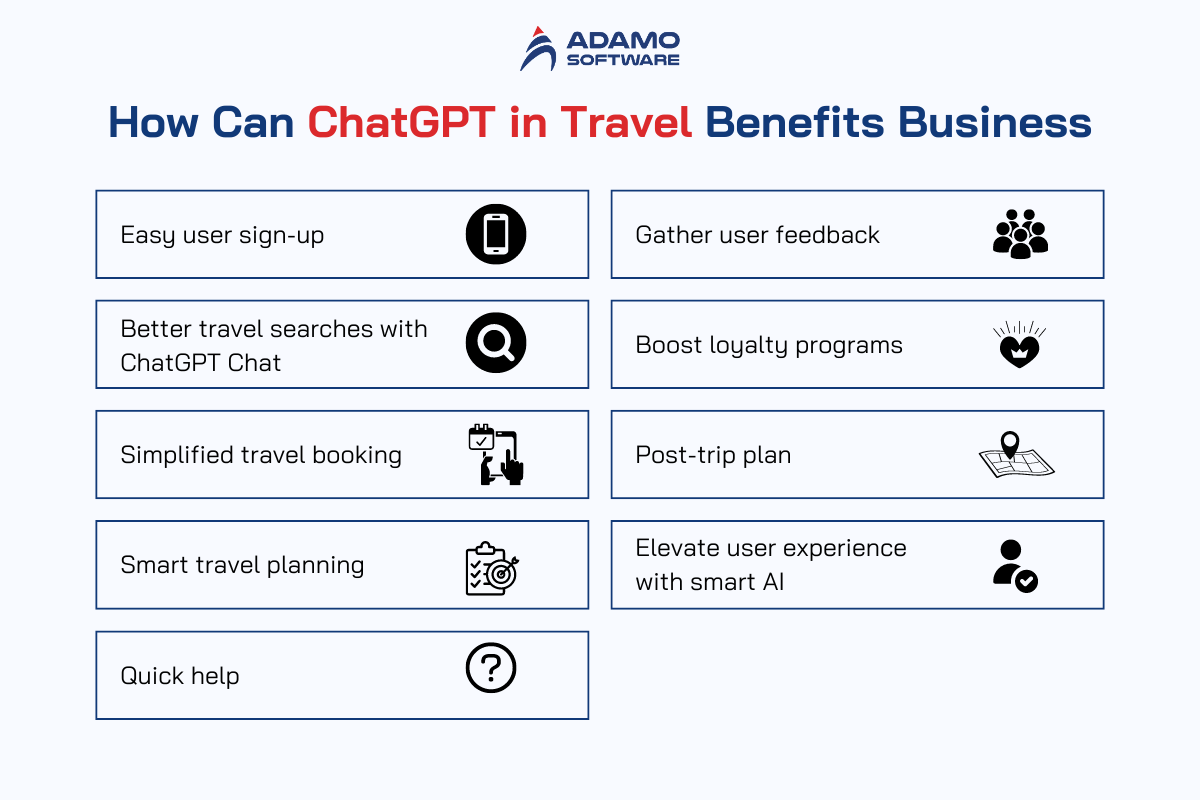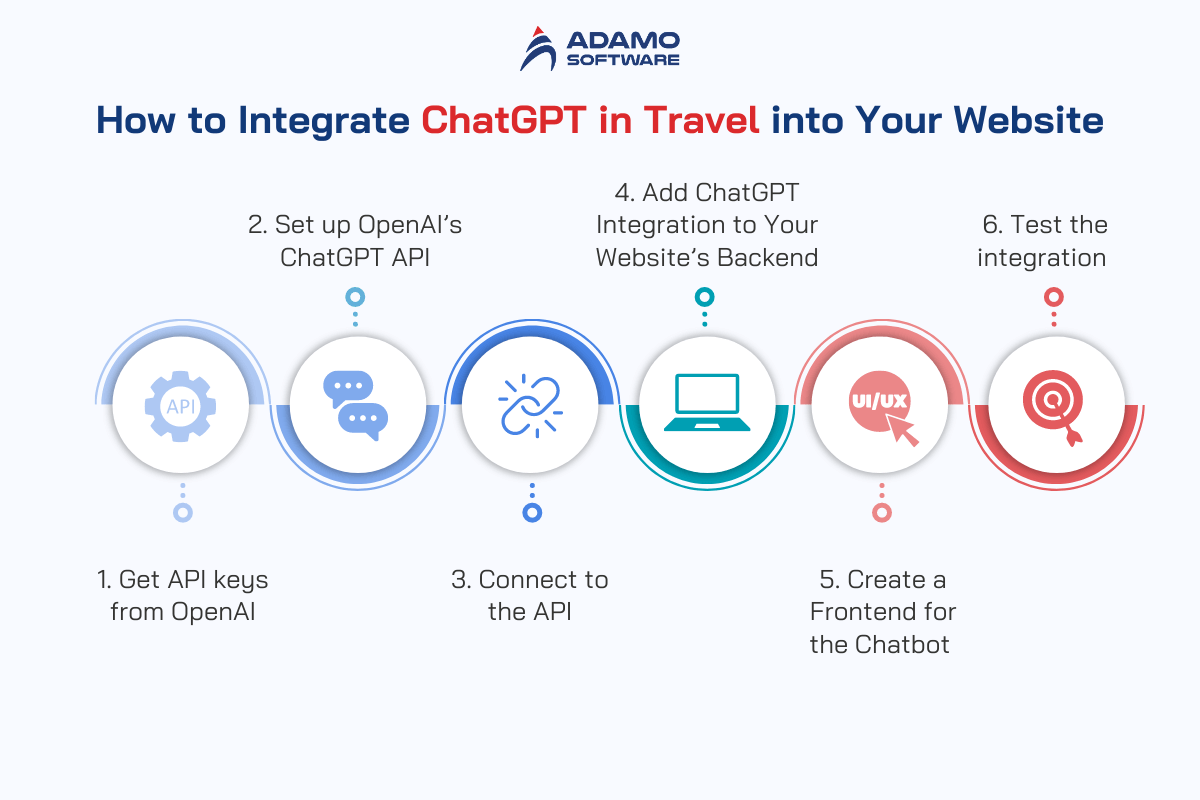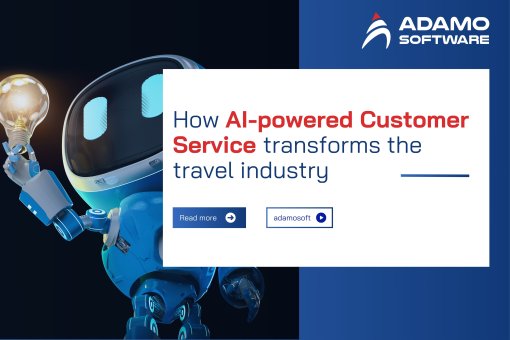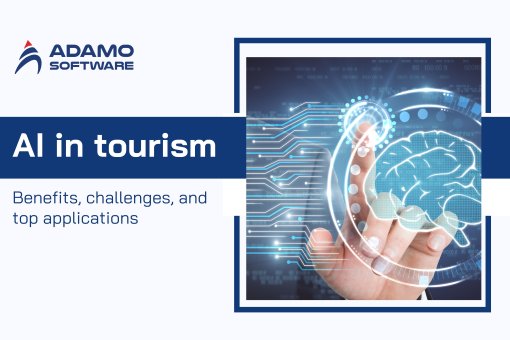ChatGPT API Integration: How to Leverage Potential of ChatGPT in Travel

ChatGPT API integration is more common than ever in the travel industry. Discover how ChatGPT can help your businesses and complete guide to integrate ChatGPT.
Today, we’re in a new age of technology with AI at the forefront. About 55% of companies are already using AI to their advantage. The global AI market is huge, worth around $184 billion in 2024. AI’s growing influence means it could replace up to 300 million current jobs.
Every industry is being changed by this digital transformation, especially the travel industry. That’s why travel companies need to adapt to these changes or risk falling behind.
Ever thought about using ChatGPT to plan your travel?
In this tech-driven era, the travel industry is changing fast. Modern travelers want both convenience and a personalized experience. This is where ChatGPT4, the latest AI language model from OpenAI, comes in handy and offers the best solutions.
So, how does ChatGPT APT integration work? Our blog today will provide you with a guide to integrate ChatGPT into your travel applications. Now, let’s start with the basic.
I. What is ChatGPT?
ChatGPT is an AI chatbot that uses natural language processing to have conversations that sound like they’re coming from a real person. It can answer questions and create different types of written content, such as articles, social media posts, essays, code, and emails.
ChatGPT is a kind of generative AI that lets users type in prompts to get back text, images, or videos that look like they were made by a human. It’s similar to the chatbots you see on customer service websites, where you can ask questions or ask for more details on its replies. GPT stands for “Generative Pre-trained Transformer,” which is the technology that helps ChatGPT understand requests and create responses. ChatGPT learns from feedback and is trained to improve its answers over time.
_ Main function: ChatGPT API integration is a powerful tool for understanding and generating text. It uses advanced technology trained on a wide range of information, allowing it to understand and respond accurately to user inputs.
_ Easy to integrate: Adding the ChatGPT API to mobile and web apps is straightforward, making it a popular choice for developers as it can help create interactive interfaces that can keep track of conversations, understand the context, and provide useful responses. This is one of the best Travel API that improves user interaction and creates a smooth experience.
_ Ethical and safe: OpenAI ensures that the ChatGPT API is used ethically and safely. It has built-in protections against bias and privacy issues, which is important for developers who want to create reliable and trustworthy apps.
II. How Can ChatGPT in Travel Benefits Businesses?
With the growing demand for personalized and seamless travel experiences, travel companies are increasingly turning to advanced technologies like AI and chatbots to enhance customer engagement and satisfaction. And ChatGPT API integration has gained popularity in the last year.
Now, let’s see how ChatGPT benefits travel businesses:

1. Easy User Sign-Up
ChatGPT can help new users quickly create profiles and explore the app’s features as it uses friendly prompts to guide them through the process, making it easy to set preferences and get started right away.
2. Better Travel Searches with ChatGPT Chat
What’s more, users can effortlessly find the best flights, hotels, and activities by simply asking questions, just like talking to a knowledgeable friend. For example, you can ask for a beach hotel in Maui under $300 for the next weekend, and ChatGPT will show you the best options.
3. Simplified Travel Booking
ChatGPT can also assist with booking questions about payment options, cancellation policies, or loyalty points. It guides users step-by-step through the booking process, making it super easy to plan their trips.
4. Smart Travel Planning
Travellers can choose the best fitting routes and attractions thanks to ChatGPT recommendations based on your interests. It’s like having a personal travel guide that provides instant tips and advice on where to go and what to see.
5. Quick Help
If there’re any updates on flight changes, local support, or emergency services, ChatGPT API integration can assist to send notifications and adjust information. For foreign travelers, it’s also handy for translating languages.
6. Gather and Use Travel Feedback
ChatGPT for travel can collect feedback after a trip and provide answers to any questions during the feedback process. Thanks to this, you can analyze and enhance the app’s user experience by using these insights from real travelers.
7. Boost Loyalty Programs
ChatGPT API integration can keep customers informed about promotions and explain how to use loyalty points. So that managing and understanding loyalty programs is easier and more engaging.
8. Post-Trip Plan
ChatGPT will assist users with filing complaints, understanding the refund process, or finding lost items.
9. Elevate User Experience with Smart AI
One of the primary advantages of ChatGPT is maintaining conversation context, allowing ChatGPT to remember your preferences and past interactions. So that the AI feels like a true assistant by providing relevant suggestions and creating a smooth user experience.
III. ChatGPT API Integration Applications in Travel Industry
The travel industry is now applying AI models like ChatGPT to make things more efficient, improve customer experiences, and find new ways to grow.
Here’s a look at some common ways ChatGPT is being used in travel and how it’s changing the industry:
1. Personalized Trip Planning
Making trips more personal and planning them better has become essential in travel as each traveler has their own requirements and needs for their trip planning. ChatGPT API integration helps a lot with this by understanding what users like and want, and then giving them travel suggestions that fit their needs. It can also help with planning detailed trips.
For example, Expedia, a big online travel platform, has added ChatGPT API integration to their mobile app to help with planning trips through conversations. When users open the app, they see a message: “Planning a new escape? Let’s chat. Explore trip ideas with ChatGPT.” This starts a chat where users can get personalized recommendations on where to go, where to stay, how to travel, and what to do.
Expedia also created a ChatGPT plugin available on the OpenAI website. Its plugin acts like a virtual travel agent, suggesting flights and hotels based on user preferences.
2. Chatbots and Customer Service
Chatbots, especially models like ChatGPT, help travel companies communicate better with customers by giving quick answers to questions and offering personalized travel tips.
KAYAK, a travel search engine, uses ChatGPT to improve its customer service. With ChatGPT, KAYAK acts like a smart virtual travel assistant. Users can ask questions in everyday language and get customized answers based on their needs and KAYAK’s large collection of travel data.
3. Travel Data Analysis
Another interesting way ChatGPT API integration is used in travel is for analyzing data. ChatGPT can understand and go through a lot of information like customer reviews and social media comments to find valuable insights about what customers like and market trends so that businesses make better decisions.
Nowadays, airlines and hotel chains can use ChatGPT to look at customer feedback and find areas to improve. By understanding what customers say in their reviews, businesses can adjust their services to meet and even exceed customer expectations.
III. How to Integrate ChatGPT in Travel into Your Website
Now, we’ll walk you through the step-by-step process of integrating ChatGPT into your travel website, from obtaining the necessary API keys to setting up the backend and creating a user-friendly interface.

1. Get API Keys from OpenAI
To get ChatGPT working on your website, you first need API keys from OpenAI. Here’s how you can get them:
_ Sign up for an account: Go to the OpenAI website and create a new account if you don’t already have one.
_ Find the API key section: Once you’re logged in, look for the section on the website labeled ‘API Keys’ or something similar. This is where you can create and manage your API keys.
_ Create a new API key: This usually involves clicking a button that says ‘Create API Key’ and then naming it something you’ll remember.
_ Store your API key safely: Copy the API key and save it somewhere secure, like a password manager. You’ll need this key to connect your website to ChatGPT, and you don’t want to lose it or let it get into the wrong hands.
2. Set Up OpenAI’s ChatGPT API
Next, you need to set up the ChatGPT API integration, involving preparing your website to use the ChatGPT service by following OpenAI’s guidelines.
Start by reading the OpenAI API documentation to understand how to use the API, including how to send requests and receive responses.
Then, make sure you have the required software or tools installed on your server such as specific programming languages or libraries that are needed to work with the API.
Also, don’t forget to set up your environment variables or configuration files to include your API key so that your website knows where to find and how to use the ChatGPT API integration key you obtained earlier.
3. Connect to the API
Now, you need to connect your website to the ChatGPT API. This means setting up a part of your server that can talk to the ChatGPT service and bring back responses.
You’ll need to create a new route or endpoint on your server. This is like making a new page on your website that specifically handles requests to and from ChatGPT.
Besides, you also need to write code in your server’s programming language that will make a request to the ChatGPT API. Remember to make sure your code also handles the responses from ChatGPT properly.
4. Add ChatGPT API Integration to Your Website’s Backend
Start this step by modifying your website’s backend code to include functions that interact with ChatGPT such as adding new code that sends and receives messages from the ChatGPT API integration.
The security of the communication between your website and the ChatGPT API is very important. You can use HTTPS to encrypt data and prevent unauthorized access.
What’s more, you should test this part of the integration to make sure everything is working as expected.
5. Create a Frontend for the Chatbot
Now is frontend development, where users will interact with ChatGPT API integration.
A simple and user-friendly chat interface is what users need. You can include features like a ‘Send’ button for submitting questions and maybe even a loading indicator to show that ChatGPT is working on a response.
Then, connect the frontend to the backend so that user inputs are sent to your server.
6. Test the Integration
Finally, before launching, remember to thoroughly test your ChatGPT integration to ensure it works well and provides a good user experience. If there are any delays, see if you can speed up the communication between your website and the ChatGPT API integration.
IV. Expert Tips for ChatGPT API Integration
To make the most out of ChatGPT API integration, it’s important to customize it to fit your brand’s style and meet your audience’s needs. Here’s how to optimize ChatGPT for a better user experience:
1. Teach ChatGPT in Travel About Your Business
ChatGPT is great at learning and adapting. If you provide it with information specific to your business, you can help it understand your products, services, and common customer questions. This way, it can give accurate and helpful answers to your users.
2. Match ChatGPT’s Tone to Your Brand
It’s vital that ChatGPT’s way of talking matches your brand’s personality. If your brand is formal and professional, ChatGPT should sound that way too. If your brand is more relaxed and casual, let ChatGPT reflect that. Keeping the tone consistent with your brand helps build trust with your users.
3. Make Interactions Personal
ChatGPT can remember user preferences and past interactions to provide a personalized experience. So that you can utilize this feature to give tailored product recommendations, share useful information, and make interactions more engaging and relevant to each user.
4. Keep ChatGPT Updated
Regularly update ChatGPT and improve it based on user feedback and interactions to help ChatGPT be effective and useful for your users over time.
By customizing ChatGPT and continuously enhancing it, you can make sure it fits well with your brand and serves as a helpful and engaging tool for your users.
V. Why Hires Adamo as a Reliable Software Development Partner for Integrating ChatGPT in Travel into Your Apps
ChatGPT isn’t just for chatbots and personalization. Its applications go much further and can be quite surprising. At Adamo Software, we’ve been experimenting with this AI model in real-life situations. Our goal is to solve complex problems, enhance the software solutions we provide to our clients, and better understand what this technology can do.
Our team can integrate AI into your existing IT systems. This can help your business engage customers better and increase revenue while reducing human errors. With our strong technical skills, Adamo can give your business cutting-edge travel software development solutions, helping you stay ahead of your competitors.
Adamo Software offers advanced AI development services to help businesses automate their operations and make smarter decisions. By providing deep insights from data, our AI services enable data-driven innovations that can modernize your business.
If you’re thinking about ChatGPT API integration for your travel solutions, contact us today for more information and support.











